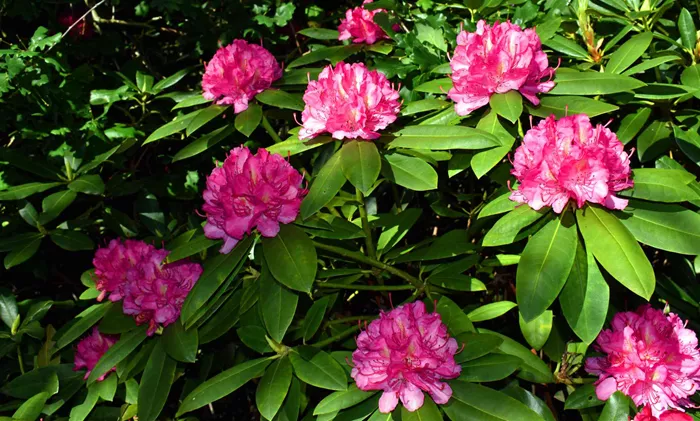Rhododendrons are beautiful flowering shrubs that add vibrant color to gardens, but when their flowers die, it can be a bit concerning for gardeners. Understanding why this happens and how to care for your plant afterward is essential for maintaining healthy rhododendrons. This article offers a detailed guide on what to do when rhododendron flowers die, including identifying causes and taking preventive measures for future blooms.
Why Do Rhododendron Flowers Die?
Rhododendrons, like any other plant, can suffer from various conditions that lead to the death of their flowers. Some common reasons include environmental stress, disease, pests, and improper care. Understanding the root cause can help you take appropriate steps to prevent this from happening in the future.
Environmental Stress and Flower Death
Rhododendrons thrive in specific environmental conditions. If the plant is exposed to excessive heat, drought, or poor soil drainage, its flowers may not survive. These plants are native to regions with cool, moist conditions and acidic soil, so any deviation from these needs can result in flower loss.
Diseases That Affect Rhododendron Flowers
Various diseases can affect rhododendrons, leading to flower death. One of the most common is phytophthora root rot, a fungal disease that attacks the roots and prevents the plant from absorbing nutrients and water. Another culprit is powdery mildew, which can cause the flowers to wither and die prematurely.
Pest Infestations and Their Impact on Flowers
Rhododendrons can also fall victim to pests such as aphids, caterpillars, and the notorious root weevil. These pests feed on the plant’s leaves and flowers, weakening the plant and causing the flowers to die. Regularly checking for pests and taking action quickly can prevent significant damage.
Improper Care Leading to Flower Decline
Improper care is another common cause of rhododendron flower death. Overwatering, underwatering, or using the wrong type of fertilizer can all harm the plant’s ability to thrive and bloom. Ensuring you provide the right care for your rhododendron is key to preventing flower loss.
Steps to Take When Rhododendron Flowers Die
When you notice your rhododendron flowers have died, don’t panic. There are several steps you can take to improve the plant’s health and encourage new growth. These steps involve assessing the plant’s needs, addressing environmental factors, and taking preventive actions for the future.
Inspect the Plant for Pests and Disease
Start by closely inspecting the plant for any signs of pests or disease. Look for visible insects on the flowers, leaves, and stems, as well as any unusual discoloration or spots that might indicate fungal infections. If pests or disease are present, use appropriate treatments such as insecticidal soap or fungicide to help the plant recover.
Prune Dead Flowers and Damaged Growth
Pruning is a crucial step in helping your rhododendron recover after flower death. Remove any dead or damaged flowers, as well as any unhealthy branches or leaves. This will not only improve the plant’s appearance but also redirect its energy toward healthy growth.
Assess and Improve Soil Conditions
Check the soil around your rhododendron. Ensure it is well-draining and acidic, as these plants do best in such conditions. If the soil is too alkaline, consider adding sulfur to acidify it. Poor soil drainage can also lead to root rot, so amend the soil with organic matter to improve its texture and drainage.
Ensure Proper Watering Practices
Watering is a critical factor in rhododendron health. Ensure you’re not overwatering or underwatering your plant. Rhododendrons prefer consistent moisture, but the soil should not remain soggy. A layer of mulch around the base of the plant can help retain moisture and prevent the roots from drying out.
Fertilize Correctly
Fertilization is an essential aspect of maintaining healthy rhododendrons. However, over-fertilizing can harm the plant. Use a balanced, slow-release fertilizer formulated for acid-loving plants, and apply it in early spring before the plant blooms. Avoid fertilizing in late summer, as this can encourage new growth that may not survive the winter.
Provide Adequate Sunlight and Shade
Rhododendrons generally prefer dappled sunlight or partial shade. Too much direct sunlight can stress the plant and cause flower death. Ensure the plant is planted in a location that provides the right balance of light and shade, particularly during the hottest parts of the day.
Preventive Measures for Future Blooming
After taking care of the immediate issues that caused your rhododendron flowers to die, it’s essential to take steps to prevent the problem from recurring in the future. Proper care, regular monitoring, and timely action can help ensure your rhododendron thrives and produces beautiful flowers year after year.
Monitor Regularly for Pests and Diseases
Regularly inspect your rhododendron for signs of pests and diseases. Early detection can help prevent a minor issue from becoming a major problem. Treating infestations and infections early will minimize damage and keep the plant healthy.
Optimize Growing Conditions
Ensure your rhododendron is planted in the best possible conditions. This means well-draining, acidic soil and a location with appropriate sunlight and shade. You may also want to consider adding organic matter to improve soil structure and fertility.
Fertilize Appropriately
Stick to a proper fertilization schedule. Apply fertilizer during the growing season, but avoid fertilizing too late in the year. A healthy, balanced diet will help your rhododendron grow strong and resilient, leading to more robust flowers in the future.
Provide Winter Protection
Rhododendrons are sensitive to cold temperatures, particularly in winter. To protect them from frost damage, cover the plant with burlap or an appropriate winter cover if you live in an area with harsh winters. This will help preserve the plant’s health and ensure it blooms in the spring.
Conclusion
Dealing with dead rhododendron flowers can be frustrating, but it’s essential to understand the causes and take corrective action. Whether it’s pests, disease, or environmental stress, identifying the root cause and addressing it with proper care and preventive measures will help your rhododendron flourish. With attention to detail and appropriate care, you can enjoy vibrant blooms year after year.


